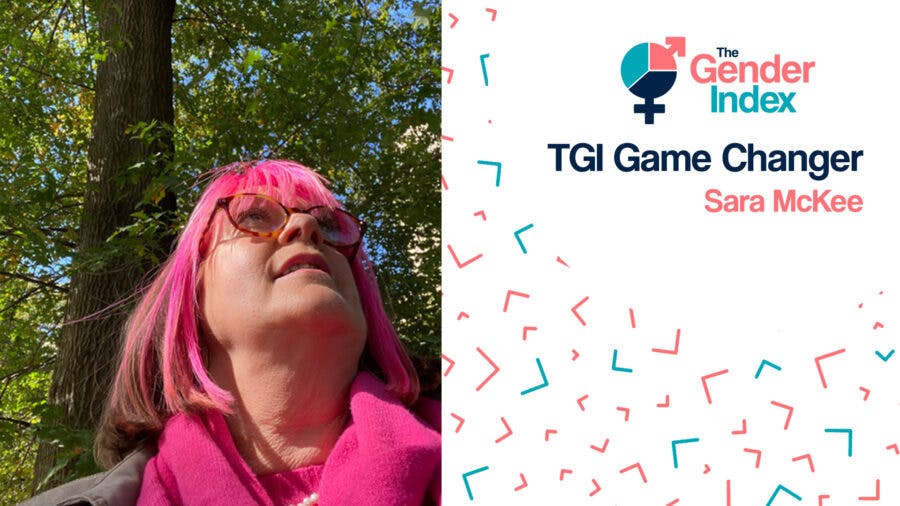We use cookies to effortlessly improve your experience on our site. Cookies also help us understand how our site is being used, so that we can keep making it better. You can read more about it in our cookie policy and change your settings here at any time.
“My companies are founded on the principle that we should live life every day, and at whatever age, we have purpose”

Next up from our community of TGI game changers is Sara McKee. The inspiring founder of Evermore, a social care company that champions a happy later life, designs spaces and sets up communities of small households which provide a family-style environment for older people who want a home for life.
A huge disruptor in this space, Sara’s vision champions celebrating later life and rejects the traditional ‘old people’s home.’
A creative and resourceful leader, she also founded Life: Full Colour, a creative platform for artists and art enthusiasts and an art gallery based in Caernarfon, Wales.
She shares with us her journey; and her advice for others following the entrepreneurial path.
As the founder of two very different businesses (care sector and art!). Can you give me a brief overview of what each means to you?
What they have in common is the principle that we should live life every day, and at whatever age, we still have purpose.
So, our Evermore business is predicated on older people having choices and not being incarcerated in care homes or gated villages.
Evermore disentangles the whole proposition of institutional care, and provides a place to live in! Often where residents can embrace later life, close to shops and restaurants for example. With care staff that operate more as housekeepers than traditional care staff.
We remind everybody that, just because people are of a certain age, they don’t necessarily need care. They might need more activity, and a reason to get up, with their horizons broadened rather than shrunk to nothing.
And, similarly, Life: Full Colour embraces that spirit and freedom to explore the art world! I studied art history 35 years ago and you needed a private income to work in galleries or auction houses. And much of what was written about art wasn’t speaking to the everyday art enthusiast.
Following the death of my husband in 2011, I set up a website where I could talk about art, because critics’ observations are often inaccessible for many interested in the subject. And from there set up the space and gallery in 2020 in an iconic building in beautiful Caernarfon.
What was the inspiration for each and how did they come about?
So, for Evermore, it was embracing the reality that nobody wants to live in a care home. Even the best ones don’t appeal to most people. It’s institutional, and often monotonous.
When I worked for a large care provider, I used to go to some of our sheltered housing schemes and tenants would ask when they have to have a shampoo and set, wear beige and crimplene pleated skirts. Who says that’s got to happen?! At Evermore, we came to the realisation we shouldn’t have to live a beige life, we should be able to live life in full colour. So, when we opened the gallery it made sense to call it Life: Full Colour.
What have been the biggest highs?
I always love it when I sell a painting in the gallery, because this is a discretionary fine art purchase. They are expensive, and are original pieces. And people fall in love with something and they come back! There’s an innate emotional response to this, which is really powerful. It’s brilliant because you talk to people about their lives, their art, where they live, what their kids are doing, where they’ve gone on holiday. I like people, so the gallery is great and the best moments are when I’ve got the artists here or one of the collectors.
On the Evermore side, what’s given me the most enjoyment is the fact that we’ve got so much recognition. So, as a tiny organisation, we’ve written papers, we’ve written blueprints and manifestos. Andy Burnham (Manchester mayor) has referenced us in speeches and admires our vision.
What have been the biggest challenges?
Funding has been a huge challenge at Evermore. Investors often won’t take risks. It’s frustrating to see traditional care homes being backed, despite the problems of that model. And there has been scepticism about communal living, despite the fact that’s really what care homes offer. Investors going with what looks like a safe bet can be very disheartening.
For Life: Full Colour, the pandemic was probably the biggest challenge. I signed a deal for the building in February 2020. Then came all the costs and no chance of getting it open!
What are your top three tips for female founders?
Don’t be afraid to be yourself! I wouldn’t be so alpha female now as I have in the past.
Be direct! Innovators and entrepreneurs have loads of ideas going on at once, and if you try to download them all to your closest colleagues it can melt them. So, you have to be very clear on what’s coming next.
But also, don’t be afraid to change track. With Life: Full Colour we were intending to run workshops and then the pandemic struck and things had to pivot. Now, my gallery is better known for contemporary art and I do workshops in a different building.
Finally, have brilliant people that are different to you. My business partner is my polar opposite; thoughtful, reflective, risk averse and detail oriented. So, she’s probably kept me out of jail!
What is the one piece of advice you wish you’d been given at the start of your journey?
Don’t listen to naysayers! And be true to yourself and help people. I’ve lost out on things because I don’t play politics. And see the huge value in mentoring, both giving and receiving.
How do you think The Gender Index can help grow female entrepreneurship?
Aside from the obvious value of the data, it’s building a community. Female business leaders sharing their stories and helping out others. I think it’s very important for us to grow this community and learn as much as we can from each other.

